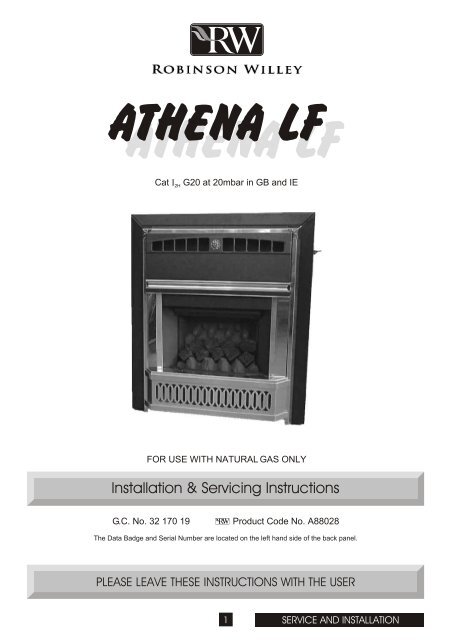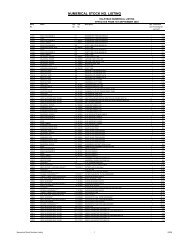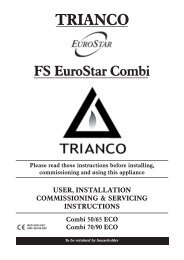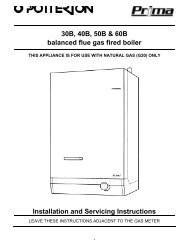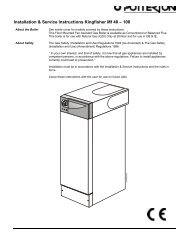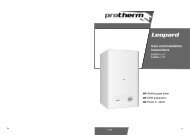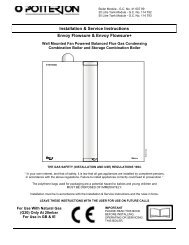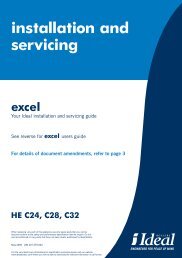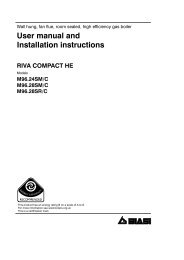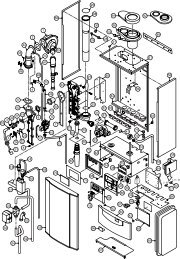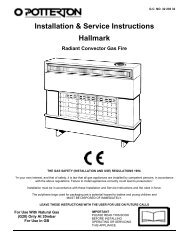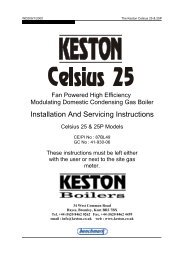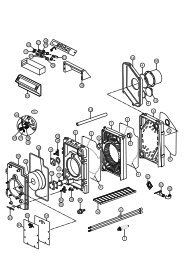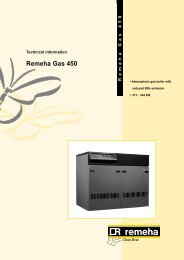Athena LF NG Installation Instructions Part No 989882 - Free boiler ...
Athena LF NG Installation Instructions Part No 989882 - Free boiler ...
Athena LF NG Installation Instructions Part No 989882 - Free boiler ...
Create successful ePaper yourself
Turn your PDF publications into a flip-book with our unique Google optimized e-Paper software.
ATHENA ATHENA <strong>LF</strong> <strong>LF</strong>Cat I G20 at 20mbar in GB and IE2HFOR USE WITH NATURAL GAS ONLY<strong>Installation</strong> & Servicing <strong>Instructions</strong>G.C. <strong>No</strong>. 32 170 19ÿ Product Code <strong>No</strong>. A88028The Data Badge and Serial Number are located on the left hand side of the back panel.PLEASE LEAVE THESE INSTRUCTIONS WITH THE USER1 SERVICE AND INSTALLATION
CONTENTS LAYOUTINTRODUCTION AND GENERAL INSTALLATION REQUIREMENTS1.0 TECHNICAL DATA2.0 CONDITIONS OF INSTALLATION2.1 SITI<strong>NG</strong> GENERAL2.2 FLUES AND CHIMNEYS2.2.1 Brick Chimney, 178mm diameter (7 inch) Stone or Lined Flue and 125mm diameter (5 inch) Flue2.2.2 Pre-Cast Flue2.2.3 Metal Fluebox 125mm diameter (5 inch) Flues2.3 SHE<strong>LF</strong> HEIGHT AND SIDE CLEARANCES2.3.1 Combustible Shelf2.3.2 <strong>No</strong>n-Combustible Shelf3.0 INSTALLATION OF FIRE3.1 UNPACKI<strong>NG</strong>3.2 PREPARATION OF FIRE3.2.1 Spigot Restrictor3.3 METHODS OF INSTALLATION3.3.1 Fixing by Tension Cable3.3.2 Fixing Directly onto Wall3.4 GAS CONNECTION3.4.1 Concealed Connection3.4.2 Front Connection3.5 TEST FOR GAS SOUNDNESS4.0 COMMISSIONI<strong>NG</strong>4.1 INSTALL FUEL EFFECT COMPONENTS4.2 CHECK GAS PRESSURE4.3 FIT TRIM AND FENDER4.4 TEST FOR SPILLAGE4.5 CHECK IGNITION4.6 CHECK OPERATION OF FSD5.0 INSTRUCT USER6.0 SERVICI<strong>NG</strong> INSTRUCTIONS6.1 REMOVE BURNER TRAY6.2 MAIN BURNER INJECTOR6.3 GAS TAP ASSEMBLY6.4 PILOT ASSEMBLY6.5 FUEL EFFECT COMPONENTS6.6 MAIN BURNER6.7 CONTROL KNOB6.8 IGNITION UNIT6.9 IGNITION BATTERY6.10 IGNITION MICRO SWITCH6.11 THERMOCOUPLE BREAK MICRO SWITCH7.0 HINTS ON FAULT FINDI<strong>NG</strong>8.0 SHORT LIST OF PARTS2
INTRODUCTIONNO COMPONENT OF THIS FIRE IS MANUFACTURED FROM ASBESTOS OR ASBESTOS RELATED PRODUCTS.The ATHENA L.F. is an open fronted inset live coal effect gas fire specially designed for Pre-Cast Flue application and is alsosuitable for use with Brick Chimneys, twin walled or insulated Metal/Pre-fabricated Flues of 125mm minimum diameter andFlueboxes conforming to the constructional requirements of BS 715. It is fitted with a combined flame supervision and oxygendepletion monitoring device. The fire is for hearth mounting only on a non-combustible hearth. The fire is for use on Natural Gasonly.GENERAL INSTALLATION REQUIREMENTSIn your own interest and that of safety, it is the law that all gas appliances are installed by competent persons in accordance withthe current Gas Safety (<strong>Installation</strong> and Use) Regulations. Failure to install appliances correctly could lead to prosecution.The installation MUST be in accordance with these installation instructions, all the relevant parts of the Local and National BuildingRegulations or Building Standards (Scotland) (Consolidation) Regulations and the relevant recommendations of the current editionsof the following British Standards:B.S. 5871 : <strong>Part</strong> 2B.S. 5440 : <strong>Part</strong>s 1 & 2B.S. 6891B.S. 6461 : <strong>Part</strong>s 1 & 2B.S. 715B.S. 1251B.S. 1289 : 1975B.S. 1289 : <strong>Part</strong> 1 : 1986B.S. 1289 : <strong>Part</strong> 2 : 1989Any other relevant British Standard Code of Practice and/or Local Building Regulations and in accordance with the rules in force.1.0 TECHNICAL DATA1.1 DIMENSIONS(Overall)mmHeight 682Width 635Depth 115Forward Projection 100Height to top of flue aperture 529Weight18 Kg1.2 INPUTS AND PRESSURESMaximum Heat Input (Gross) 6.0 kW 20470 Btu/hMinimum Heat Input (Gross) 2.3 kW 7848 Btu/hSupply Pressure20.0 mbarSetting Pressure Cold13.0 mbar ± 1mbarGas Rate AdjustmentNONE1.3 BURNER AND CONTROL DETAILSMain Burner ÿ 992174Pilot Burner SIT OP 9063Injector (Main Burner) Bray Cat 82/440IgnitionBattery Operated Electronic Ignition. Battery Size 9V MN1604 or 6LR61Control Tap Concentric (with FSD) Model Number TESA 2762-025Spark Gap3.0mm to 5.0mmControl Knob SettingsOFF, HIGH, MED, ECON, PILOT3
2.0 CONDITIONS OF INSTALLATION2.1 SITI<strong>NG</strong> GENERALThis fire is suitable for hearth mounting only on a non-combustible hearth at least 13mm thick and measuring at least 630mm wideby 330mm deep. Its top surface should preferably be 50mm above the floor level in order to discourage the placing of carpets orrugs over it. It MUST NOT be fitted directly on a combustible wall. The fire should be installed so that no part of a combustible walloi.e. not part of the fire surround but a full wall at 90 to the fire is less than 500mm from the radiant source. If this is not possible thecombustible side wall must be suitably protected.FIREPLACE OPENI<strong>NG</strong>The front opening of the fireplace must be between 305mm and 457mm wide and between 560mm and 585mm high (see Section2.2). If the opening is greater it must be bricked up until the opening is a maximum of 585mm high and 457mm wide, alternatively anon-combustible infill panel may be used to achieve the required dimensions.DO NOT USE THE BACK OF A FIRE SURROUND OR MARBLE TO ACHIEVE THE ABOVE DIMENSIONS.There must be a minimum flat surface area around the fireplace opening shown by the dotted lines in fig. 1 to ensure a good sealbetween the fireplace and the fire. This area should be sound enough to take the wall plugs and screws supplied for front fixing.Ensure that the base of the fireplace is level with the hearth and reasonably flat to prevent the fire rocking. Purpose built ventilationbricks or additional air vents are not normally required in the room in which the fire is fitted unless specified by the rules in force.IMPORTANT: When fitting any heating appliance or wallpapering a room in which one is fitted, soft wall coverings such as heatsensitive wallpapers may become heat damaged or discoloured especially in the area above the fire. Please bear this in mindwhen installing or decorating.IMPORTANT NOTEPlaster Applied Directly to Pre-cast Flue Blocks.Some Pre-cast flues built to B.S. 1289:1975 may have plaster applied directly to the flue blocks.A recommendation was made, in the revision B.S. 1289 part 1:1986, NOT to apply plaster directly to the flue blocks, otherwisecracking of the plaster could occur.It is not recommended to install this fire into such installations, unless remedial action is taken.2.2 FLUES AND CHIMNEYS2.2.1 SITE REQUIREMENTS FOR 228mm BY 228mm (9in BY 9in) BRICK CHIMNEY/178mm (7in)STONE OR LINED CHIMNEY AND 125MM (5in) DIAMETER FLUEThe minimum dimensions for the fireplace opening for a brick chimney are as shown in Fig. 1. It will not normally be necessary toremove any chair brick provided the minimum depth is obtained. A chimney previously used to burn solid fuel must be swept priorto installation.The chimney must be inspected to ensure that:(a)(b)(c)(d)It serves only one fireplace.It is properly sealed so that combustion products do not escape from the flue into the room.It is not blocked by paper, rubble etc.Any restriction such as damper, register plate, etc. must be removed or secured in the fully open position.(e)(f)(g)Any underdraught ventilation or additional air supplyentering the fireplace or on the hearth must besealed off.It must have at least 3 metre effective flue height.It must have a positive updraught.635 mm MINCHECK THE FLUE FOR GOOD DRAUGHTApply a lighted paper or smoke match to the top of theopening in the fireplace. Observe if there is a definite flowinto the chimney and if so proceed with fitting the fire.If no flow is indicated, warm the chimney for several minutesand then re-check. If downdraught is observed a suitableterminal must be fitted and the chimney re-checked.If persistent no-flow or downdraught condition is observed686 mm MINDO NOT FIT THE FIRE, SEEK EXPERT ADVICE.Fig. 14
2.2.3 METAL FLUE BOX/125mm DIAMETER FLUES(Figs. 3A and 3B)This fire may be installed in a double walled or insulatedmetal box built to the requirements of B.S. 715 e.g.Selkirk, Product Code Number 0404805, using ourfixing kit G.C. Number 159 634 ÿ Number 992137.The box must be lagged as detailed in Fig. 3B andmounted on a non-combustible plinth at least 25mmthick. Ensure that the base of the opening is level withthe hearth. A larger box built to the requirements of B.S.715 and insulated as in Fig. 3B may be used. The frontopening must be as shown in Fig. 3A. The flue shouldbe twin walled e.g. Selkirk IL flues, or insulated type ofat least 125mm internal diameter and with a minimumeffective height of 3 metres. The depth of the openingmust be at least 200mm.98FLUECENTRE125 I/D457NOTES:1. If the flat area around the front opening of the boxis less than as specified in Fig. 1, it may benecessary to use additional sealing material toachieve a good seal.2. The flue spigot restrictor MUST NOT be fitted.560200610407212FREESTANDI<strong>NG</strong>GAS FLUE BOXSELKIRK CODE 0404805Fig. 3ARefer to the followingillustrations forconfiguration.Cover the top, rear andsides of the fire housing asshown with 100mm (4in)loft insulation material asshown. If the gap betweenthe fire housing and anycombustible material isless than 100mm, squeezethe insulation materialbetween the two surfaces.The minimum distancefrom any studding or othercombustible material andthe flue pipe or any part ofthe fire housing must be25mm (1in).Fire housingSealant<strong>No</strong>n-combustible firesurround material<strong>No</strong>te: The plaster board does not overlap theedge of the fire housing. Any non-combustiblefire surround material used overlaps asshown. The non-combustible fire surroundmaterial must be sealed to the fire housing.<strong>No</strong>n-combustible firesurround materialThe non-combustible materialmust be sealed to the firehousing to form an air tight sealall around.Fig. 3B6
2.3 SHE<strong>LF</strong> HEIGHT AND SIDE CLEARANCESThe fire may be fitted beneath a shelf.2.3.1 COMBUSTIBLE SHE<strong>LF</strong>The underside of a combustible shelf not more than 150mm deep must be at least 923mm from the hearth which gives a clearanceof 237mm above the fire. For deeper shelves, add 13mm shelf height for every 25mm increase in depth. For every 25mm decreasein shelf depth subtract 13mm from the shelf height.2.3.2 NON-COMBUSTIBLE SHE<strong>LF</strong>The underside of a non-combustible shelf not more than 75mm deep must be at least 25mm above the top of the fire. Thisclearance is necessary for outer case removal. For deeper shelves, allow 13mm in shelf height for every 25mm increase in depth.SIDE CLEARANCES:A clearance of at least 25mm must be left on either side of the fire to facilitate removal of the outer case during servicing.FIRE SURROUND:oThe fire is suitable for purpose-made proprietary hearths/surrounds with temperature rating of 150 C.3.1 UNPACKI<strong>NG</strong>3.0 INSTALLATION OF FIREThe fire is packed with the back coal and side cheeks already fitted in position. When unpacking refer to the check list to ensurethat all of the components are present and undamaged. Remove the top fitment from the carton. Lift the carton surround clear ofthe fire. Remove the pack containing the coal bed and 9 loose coals. Remove the outer case from the fire, by lifting the it to clearthe two top locating brackets. Lift the fire clear of the bottom fitment of the carton.Take out the polythene bag containing the fire fixing kit and comprising:(i) 2 Fixing Cables(ii) 2 Cable Adaptors(iii) 2 Grub Screws(iv) 4 Eye Screws(v) 1 Spigot Restrictor(vi) 4 Screws and Wall Plugs (fire fixing)3.2 PREPARATION OF FIRE3.2.1 SPIGOT RESTRICTORThe spigot restrictor is supplied loose with the fire andshould be fitted only in the case of installation to a brickchimney, 178mm diameter stone/lined flue of at least3 metres effective height, with good draught.DO NOT fit the spigot restrictor if installation is to aPRE-CAST FLUE or a METAL FLUEBOX / 5 INCHFLUE. Fit the spigot restrictor if applicable using2 screws (Fig. 4).SPIGOT RESTRICTOR2 SCREWSFig. 47
3.3 METHOD OF INSTALLATIONThere are two methods for securing the fire to the wall which are:(a)(b)Fixing by tension cable.Screwing the fire directly to the wall.It is recommended, where drilling holes in the front face of the fireplace surround is unacceptable or otherwise risky e.g. a marblesurround, that fixing by tension cable is employed.IMPORTANT NOTES(a) If the surface of the fireplace is uneven it is necessary to prepare the surface so that a positive seal can be achievedbetween the fire and the wall.(b) If the fire is to be connected using a concealed gas connection then it is necessary to prepare the pipework prior to fitting thefire to the wall. Refer to Section 3.4.1. (Concealed Connection).3.3.1 FIXI<strong>NG</strong> BY TENSION CABLEFIT MOUNTI<strong>NG</strong> EYE SCREWSMark the position for eye screws in the back of the opening according to the dimensions in Fig. 5. Drill the four 6mm holes and plugthe holes with the wall plugs. Fix the eye screws to the holes.FIXI<strong>NG</strong> THE CABLEFirst remove the burner tray (see Section 6.1). Insert the free end of each cable through the respective hole in the firebox and thenthrough the eye screws (refer to Fig. 5). Thread the free ends of the cable through the holes in the tensioning bolts located in thebase of the fire from the rear. Insert the fire into the opening so that the seal on the back of the fire is compressed against the faceof the fireplace/surround. Any visible gaps indicate a deviation from flatness of the surround face which MUST be corrected. Pullthe cable taut each side of the fire and insert the cable adaptors over the ends of the cable (Fig. 5). While keeping the cable tautslide the adaptor against the tensioning bolt and tighten the grub screw to lock the cable. Using a spanner unscrew each tensioningbolt by about 20mm to tension the cable. Prevent the cable adaptors from rotating while unscrewing the tensioning bolts. Refit theburner tray.Fig. 58
3.3.2 FIXI<strong>NG</strong> DIRECTLY TO SURROUND FACEMark the four positions of the fixing holes on the front face of the fireplace surround using the fire as a template. Drill 6mm holesand plug the holes with the wall plugs supplied. Insert the fire into the opening in the fireplace until the seal on the back of the fire iscompressed against the surround face at every point. <strong>No</strong>te that any visible gaps between the surround face and the seal indicate adeviation from flatness on the surround face and MUST be rectified. Screw the fire to the wall.3.4 GAS CONNECTIONNOTE: The appliance must be connected to gas with rigid or semi-rigid tubing. A means of isolating the gas supply must be fittedupstream of the appliance inlet to facilitate connection and subsequent servicing. The supply pipe to the fire should be installed sothat it is easy to remove the fire from the opening during servicing. Ensure that a service cock (which may be in the form of a unionrestrictor elbow) is provided for isolation of the fire for servicing at a later date.If a concealed connection from within the fireplace is required then, before the appliance is fitted into the fireplace, it will benecessary to extend the supply line so that it will project through the sealed opening situated at the back of the firebox to theappliance inlet elbow.3.4.1. CONCEALED CONNECTIONThe dimensions below indicate the required position of the supply pipe to enable it to pass through the aperture in the fire back.Refer to Fig. 6.(a) Remove the burner tray from the fire to improve access (see Section 6.1).(b) Make connection from concealed point to finish in the position indicated in Fig. 6.Ensure there is a union connection at this point. The inlet elbow provided with the fire should be fitted to the supply.(c)The pipe run from the supply line up to the rear opening in the firebox must be kept clear of the area which will be taken bythe box when it is installed.73mm115mmFig. 63.4.2 FRONT CONNECTIONAfter fixing the fire to the surround (Section 3.3) it is possible to connect the gas supply from either the right or left hand side. Theunion elbow on the fire which has an R 1/4 internal thread should be connected to the supply pipe.P3.5 TEST FOR GAS SOUNDNESSThe gas installation, including metre, should be inspected and tested for gas soundness and purged.Refer to B.S. 6891 : 1988 when performing gas soundness testing.9
4.0 COMMISSIONI<strong>NG</strong>4.1 INSTALL FUEL EFFECT COMPONENTSThe fuel effect components comprise:(a)(b)(c)(d)Rear CoalTwo Side CheeksCoal BedNine Loose CoalsThe Coal Bed and the loose coals are illustrated in Fig.7A. The fire is supplied with the rear coal and sidecheeks already fitted as illustrated in Fig. 7B.Unpack the pack containing the coal bed and the loosecoals and check that these are undamaged.DO NOT INSTALL THE FIRE WITH BROKEN ORMISSI<strong>NG</strong> COALS. USE ONLY THE COALS SUPPLIEDWITH THE FIRE.1. The underside of the coal bed has groovesmatching the raised ports of the burner top. Fit thecoal bed by placing it onto the burner. Take careto avoid damage as you insert it past the pilotburner (Refer to Fig. 7C). Ensure that it iscorrectly located in the burner tray by sliding itsideways and front to back.Fig. 7A2. <strong>No</strong>tice that there are five depressions at the frontof the coal bed and four depressions at the rear(as shown in Fig. 7A). Place five loose coals inthe front recesses with their decorative facesforward. Similarly place the remaining four loosecoals on top of the recesses formed by the frontloose coals and touching the rear coal (Fig. 7D).Ensure that the loose coals are stable and notlikely to fall off.Fig. 7B10
4.2 CHECK GAS PRESSURERemove the pressure test point screw located on theinjector feed pipe just left of centre on the fire. Connect apressure gauge, slide the control knob down to thePILOT/IGNITION position. Keep the knob depressedafter the pilot has lit to activate the FSD and then slide theknob to the HIGH position. Check that the gas pressure isas specified in Section 1.0 Technical Data. Turn off the fireand disconnect the pressure gauge. Replace the testpoint screw, relight the fire and test for gas soundnessaround the sealing screw using a suitable leak detectionfluid.4.3 FIT OUTER CASEAlign the bottom cut-outs in the outer case with theretaining lugs on the firebox sides. Raise the outer casevertically and then lower to engage the top onto the lugsabove the air guide, at the same time ensure that thebottom cut-outs remain on the retaining lugs.Fig. 7CFig. 7D11
4.4 TEST FOR SPILLAGEA test for spillage must be made before the installed fire is left with the user. This is carried out in the following manner. Light thefire and leave at HIGH rate. Close all the doors and windows in the room and after the fire has been alight for five minutes inserta lighted smoke match in line with the bottom edge of the canopy and 10mm below it (See Fig. 8). Hold the match with a pair ofpliers or in a metal tube. If all of the smoke is drawn into the fire the installation is satisfactory. if in doubt, repeat the test after afurther ten minutes.If there is a fan or a fan operated appliance in a connecting room then the spillage test must be repeated with the fan runningand all inter-connecting doors between the fan and the fire left open. If the fan and the fire are in the same room, close allwindows and doors connected to the room. Switch on the fan and repeat the spillage test.If spillage is detected, inspect the sealing of the fire to the surround / hearth. If this is satisfactory proceed as follows:If a spigot restrictor was fitted, disconnect the fire and remove the spigot restrictor. Re-install the fire and repeat the abovespillage test. If there is still evidence of spillage then there may be a fault with the chimney or insufficient air in the room. if thecause of the spillage cannot be corrected DISCONNECT THE FIRE AND SEEK EXPERT ADVICE.Fig. 8SMOKE MATCH10.025.0AIRBOX SIDE1. FIT CASE.2. LIGHT FIRE AND LEAVE AT FULL RATE3. CLOSE ALL DOORS AND WINDOWS4. AFTER 5 MINUTES INSERT SMOKE MATCH AS SHOWN IN THE DIAGRAM.5. SMOKE WILL BE DRAWN INTO THE FIRE IF INSTALLATION IS SATISFACTORY.6. IF SPILLAGE OCCURS, WAIT FOR 10 MINUTES AND REPEAT THE TEST.7. IF SPILLAGE IS STILL EVIDENT PROCEED AS IN FITTERS INSTRUCTIONS.4.5 CHECK IGNITIONCheck that ignition of the pilot and the cross lighting to themain burner is satisfactory.Fig. 9NB. The spark gap between the electrode andthermocouple tip should be between 3.0 and 5.0mm (SeeFig. 9).3.0 - 5.0mm4.6 CHECK OPERATION OF FSDLeave the fire running on HIGH rate for 5 minutes and thenturn off the gas at the service cock. After 3 minutes turn theservice cock on again. If the gas has stopped flowing theFSD has operated satisfactorily.NOTE: You may hear the FSD valve close within the 3minute period but always check that the gas has stoppedflowing.12
5.0 INSTRUCT USERRefer to Users <strong>Instructions</strong>Make sure the user understands the following:(a) How to light and operate the fire.(b) The fire can be lit with a match or taper in the event of failure of the battery ignition.(c) Demonstrate the removal and replacement of the coals. Advise on the need to clean these regularly.(d) Advise that for safe and efficient operation, the fire should be serviced annually by British Gas or a CORGI registered serviceagent.(e) Explain to the user the functioning of the combined flame supervision and atmosphere monitoring device as detailed inSection 6.4. Stress that if this device repeatedly shuts off the fire, the fault must be rectified immediately by a competentperson.(f) When the fire is first lit a slight smell and light smoke may be noticed but this will clear away with a few hours of use on HIGH.(g) Advise the user to carefully clean the base of the fire with a vacuum cleaner regularly.Hand over the Users <strong>Instructions</strong>6.0 SERVICI<strong>NG</strong> INSTRUCTIONSIMPORTANT NOTES1. Turn off the gas supply to the fire before starting any servicing.2. Always test for gas soundness after servicing or exchanging any component.3. Remove the fire from the surround and inspect the catchment space for build up of debris on every service visit.4. Check the fire for clearance of products on every service visit.5. Remove any lint from the top of the main burner and from around the aeration hole of the pilot and main burner.6.1 REMOVE BURNER TRAY1. Remove the outer case by lifting it upwards and away from the fire.2. Remove the loose coals and coal bed.3. Disconnect the gas supply at the inlet to the fire.4. Remove the screw from the slider valve connection to the linkage.5. Separate the yellow wires on the thermocouple break micro switch from the white wires attached to the pilot assembly.6. Disconnect the red and blue wires from the ignition unit.7. Remove the two screws securing the burner tray to the firebox and slide out the burner tray.6.2 BURNER INJECTOR1. Remove the burner tray (Section 6.1 above).2. Undo the union nuts on the burner gas inlet and at the gas valve end and remove the gas pipe.3. Undo the two screws securing the injector bracket to the burner manifold.4. Undo the nut securing the injector to its holder, and remove the injector and washer.5. Replace with the new injector.6. Re-assemble in the reverse manner.6.3 GAS VALVE / FSD ASSEMBLY1. Remove burner tray (Section 6.1 above)..2. Turn the tray upside down.3. Undo the gas connections to the gas valve.4. Release the thermocouple nut and ease out the probe.5. Undo the two screws securing the burner to its tray and ease out the gas valve and gas inlet pipe.6. Remove the two screws securing the gas valve to its bracket and remove the gas valve.7. Replace with the new gas valve/fsd assembly.8. Re-assemble in the reverse manner.13
6.4 PILOT ASSEMBLYThe pilot is an atmosphere sensing device and must be replaced as a complete unit. Repair must not be undertaken.NOTE: If the fire keeps going out or exhibits signs of nuisance shut off, check the operation of the pilot as follows:-(a) Inspect the pilot flame, if suspect check the gas supply. Clear blockage if necessary. If flame is still suspect replace pilotassembly.(b) Check the thermocouple. If faulty replace the pilot assembly.(c) Check the magnet unit in the gas valve. If faulty replace the valve.(d) Check the thermocouple break micro switch and connections.(d) Check the ventilation in the room. Vitiation may be due to lack of sufficient air supply.(e) Check for satisfactory clearance of combustion products. Vitiation may be due to spillage of combustion products into theroom.1. Remove burner tray (Section 6.1 above).2. Release the pilot supply pipe at the pilot end and ease out the pipe.3. Undo the thermocouple nut at the gas valve end and ease out the thermocouple.4. Disconnect the thermocouple wires from the yellow micro switch wires.4. Pull off the spark lead at the pilot end.5. Remove the two screws securing the pilot assembly (and insulation pad) to its bracket.6. Fit the new pilot assembly.7. Re-assemble in the reverse manner.6.5 FUEL EFFECT COMPONENTSThe loose coals and the coal bed simply lift out. To replace the rear coal and/or side cheeks proceed as follows:SIDE CHEEKS1. Remove the outer case.2. Remove the left or right retaining panel by undoing the two screws securing it to the fire body.3. Slide out the side cheeks and replace with new ones. Re-assemble in reverse order.REAR COAL1. Remove burner tray (Section 6.1)2. Remove the screws securing the lower coal support and slide out the rear coal.3. Replace with a new one, and re-assemble in reverse order.6.6 MAIN BURNER1. Remove burner tray (Section 6.1)2. Undo the two screws securing the pilot assembly to the burner.3. Undo the two screws securing the injector to the burner manifold.4. Turn the tray upside down.5. Undo the two screws securing the burner to the tray and remove the burner.6. Fit the new burner and re-assemble in the reverse manner.6.7 CONTROL KNOB1. Remove the outer case.2. Remove the two screws securing the knob to the slider linkage.3. Replace with a new knob and re-assemble in the reverse manner.6.8 IGNITION UNIT1. Remove the outer case.2. Disconnect the red and blue wires and the ignition lead from the ignition unit.3. Undo the two screws securing the ignition unit to its mounting bracket.4. Replace with a new one and re-assemble in the reverse manner.6.9 IGNITION BATTERY REPLACEMENT1. Remove the outer case.2. The battery can now be located at the bottom of the fire, fitted into the ignition unit.3. Remove the old battery from the ignition unit by pulling it out towards the right.4. Replace with the new battery of the same type (see Section 1.0 Technical Data).<strong>No</strong>te: The terminals of the battery are of different shapes to prevent incorrect connection. If it does not fit, try it the other wayround.5. Re-fit the outer case.14
6.10 IGNITION MICRO SWITCH1. Remove the outer case.2. Disconnect the red and blue wires from the ignition unit.3. Remove the two screws securing the micro switch to the fire.4. Replace with a new one and re-assemble in the reverse manner.6.11 THERMOCOUPLE BREAK MICRO SWITCH1. Remove the outer case.2. Disconnect the thermocouple wires from the yellow micro switch wires.3. Remove the two screws securing the micro switch to the fire.4. Replace with a new one and re-assemble in the reverse manner.7.0 HINTS ON FAULT FINDI<strong>NG</strong>The following are possible fault conditions. Check the items mentioned and repair or replace parts as necessary. The list is notexhaustive but a fair outline of possible faults.1. <strong>No</strong> Spark(a) Check spark by manually operating the micro switch.(b) The battery may be exhausted. Check and replace if necessary.(c) Check the spark gap and electrode alignment. The electrode, thermocouple probe and horizontal arm of the pilot burnershould be in a straight line.(d) Inspect the spark lead, ensure firm contact at the ends and that there is no shorting out of spark at either end.2. Spark but the pilot does not light.(a) Verify availability of gas at the pilot burner, if possible, light with a match.(b) If gas is available, proceed as in 1 above.(c) If gas is not available, check the pilot burner and supply pipe for blockage.(d) IMPORTANT: Remove the battery from the ignition unit to disable the spark ignition. Ensure gas is available at the pilotport of gas tap, if not replace the tap.3. Pilot lights but goes out on heat setting.Pilot starvation due to partial blockage. Clean the pilot gas supply line. See also 2(c) and 2(d) above.4. Nuisance shut off.(a) Inspect the pilot flame.(b) Check the thermocouple. If faulty replace the pilot assembly.(c) Check the thermocouple break micro switch and connections.(d) Check the magnet unit in the gas tap. If faulty replace the tap.(e) Check the ventilation into the room. Vitiation may be due to the lack of sufficient air supply.(f) Check for satisfactory clearance of combustion products. Vitiation may be due to spillage of combustion products intothe room.5. Main burner popping.Remove the loose coals and coalbed. Light the fire and inspect the burner for cracks and leakage. Replace the burner ifnecessary.6. Poor flame picture.(a) Remove the burner assembly. Check the alignment of the burner ports with the holes in the coalbed. Ensure the portsare clear.(b) Re-assemble correctly and check the flame picture.(c) Check the gas rate.7. Sooting.Proceed as in 6 above.8. Spillage.(a) Check the seal of the fire to the wall/surround.(b) Inspect the chimney.(c) Remove the spigot restrictor if fitted.(d) Check the coal arrangement.15
8.0 SHORT LIST PARTSÿ PART NUMBER DESCRIPTION822309 Gas Valve / FSD Assembly990274 Control Knob822308 Pilot Assembly (Natural Gas)993911 Spark Lead822238 Ignition Unit992232 Rear Coal992234 Coal Bed992169 Loose Coals (9 off)992178 Left Side Cheek992179 Right Side Cheek<strong>989882</strong> Issue 2ROBINSON WILLEY LIMITEDMill Lane, Old Swan, Liverpool. L13 4AJ. England.Telephone: 0151-228-9111 Fax: 0151-228-6661www.robinson-willey.co.uk16


